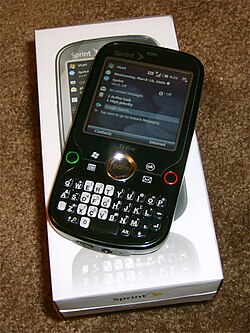 | |
| Manufacturer | Palm, Inc. |
|---|---|
| Type | Candybar smartphone |
| Release date | January 5, 2009 |
| Operating system | Windows Mobile 6.1 Professional |
| CPU | CDMA version: 528 MHz Qualcomm MSM7501A ARM11 GSM version: 400 MHz Qualcomm MSM7201 ARM11 |
| Memory | 128 MB DRAM |
| Storage | Flash memory: 512 MB (CDMA version) or 256 MB (GSM version) microSDHC slot: supports up to 32 GB |
| Display | 320 x 320 px, 3.5 in (89 mm), 65,536 color LCD |
| Input | Keyboard |
| Camera | 2 megapixel camera with 8x digital zoom |
| Connectivity | Wi-Fi (802.11b/g), Bluetooth 2.0+EDR, MicroUSB, A-GPS CDMA version includes: Dual band CDMA2000/EV-DO Rev. A 800 1900 MHz GSM version includes: Quad band GSM 850 900 1800 1900 MHz GPRS/EDGE and Tri band UMTS/HSDPA 850, 1900, 2100 MHz |
| Power | 3.7 V 1500 mAh Internal rechargeable removable lithium-ion battery |
| Dimensions | 4.49 in (114 mm) (h) 2.36 in (60 mm) (w) 0.53 in (13 mm) (d) |
| Weight | 4.69 oz (133 g) |
The Palm Treo Pro is a combination PDA/cell phone offered in both GSM and CDMA. It is Palm's fourth Windows Mobile Treo. It replaced the short-lived Sprint Treo 800w. [1]
